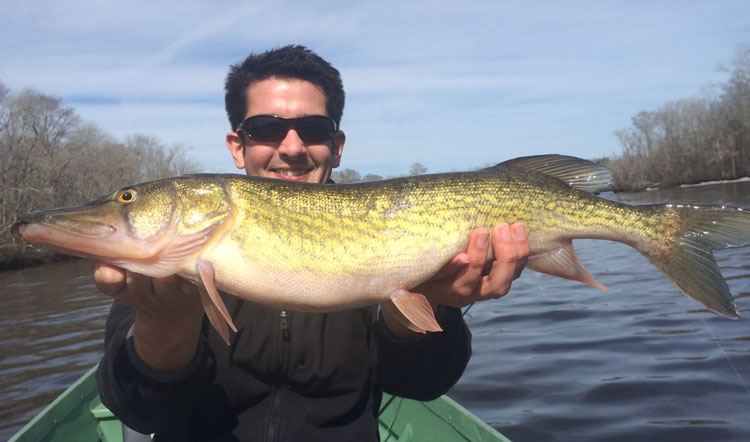
During the dark days of the fishing off-season, my husband likes to entertain our family by reading aloud passages from the obscure “Encyclopedia of Fish Cookery” by A.J. McClane, an epic culinary volume of piscatorial lore and recipes published in 1977. My teenage daughter can still quote a poem about eels she learned when she was eight, probably because it contains the word rum. When I decided to write about the chain pickerel I was sure the “Encyclopedia” would offer insights not found in more conventional resources. I was not disappointed. Before recipes and poetry, however, it is interesting to learn about the biology and life cycle of this year-round Chesapeake resident.
Chain pickerel (Esox niger), a close relative to the pike, are found along the Eastern Seaboard of the U.S. and Canada, the Gulf Coast to Texas, as well as in the Great Lakes. While primarily a freshwater species, they tolerate some salinity and are found in the headwaters of tidal creeks in the Chesapeake Bay. Pikes arrived on the Maryland Coast 30 million years ago, around the time the present Chesapeake Bay was taking shape.
Perhaps one of the original apex predators, the chain pickerel is a voracious hunter known as a “sight” predator. It lies in wait near shallow weed beds, dock pilings, or structures and lunges at its prey. Chain pickerel are known to eat frogs, snakes, killifish, minnows, and other small fish. They have been observed to lunge out of the water to eat insects. The chain pickerel will contort its body into an “S” shape to strike at its prey. The flat wide head is an ancient design, and the teeth are angled toward the back of the mouth to keep prey from escaping.
Chain pickerel typically live up to 10 years and spawn beginning in their fourth year. The female carries her eggs (roe) in March and releases the long ribbon-like masses of up to 50,000 eggs in April in the Chesapeake. The only natural predators are osprey and bald eagles, though great blue herons will eat their young.
While their bony nature makes them mostly a sportfish, according to the “Encyclopedia of Fish Cookery,” deboning is well worth the effort. “Lo, the rich pike, to entertain your guest. Smokes on the board and decorates a royal feast”—Richard the Second 1394. Whether March comes in like a lion or not, cast a line from your marina slip, and you might get lucky enough to catch this ancient fish, alive and well in today’s Chesapeake waters.
Recipe for Chain Pickerel Mousse, from the Encyclopedia of Fish Cookery
2 pounds boneles chain pickerel (author's note: easier said than done)
3 egg whites
2 teaspoons sugar
1/2 teaspoon nutmet
1/2 teaspoon white pepper
4 cups heavy cream
Crush pickerel in a mortar, and then place in a bowl set in cracked ice. Add egg whites and combine. Add cream, little by little. Work everything thoroughly with a spoon until the mixture reaches the consistency of a sticky batter.




